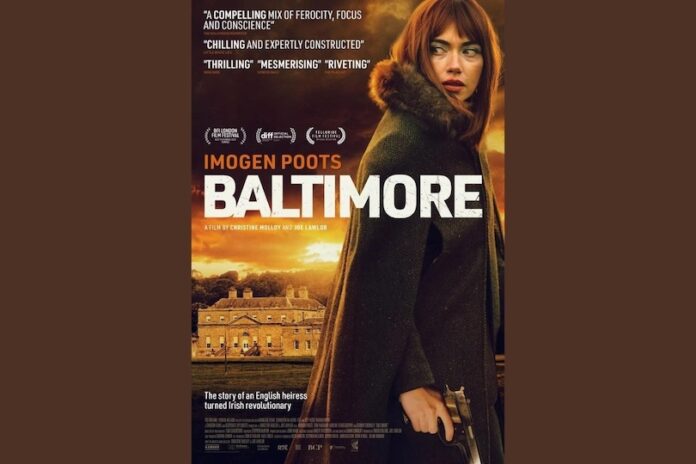Baltimore: Heiress, Rebel, Revolutionary
Directed by Joe Lawlor and Christine Molloy, 2023
IR students with an interest in political conflict will welcome this movie portrayal of one of Ireland’s most remarkable and enigmatic figures. Starring Imogen Poots in the key role, Baltimore is the life-story of the late Rose Dugdale, a British heiress turned IRA member. Screen-writing duo, Joe Lawlor and Christine Molloy eschew biopic conventions, to explore some of the contradictions in an English millionaire heiress abandoning her life of privilege to join the IRA and taking a pivotal role in one of the biggest art heists in history. Happily, the filmography appears quite true to the events and so we are treated to some historical vignettes of the financial issues driving the IRA during the 1970s, and the theft, among other major artworks, of a noted Vermeer.
The film’s successful launch, and Rose’s recent passing in Dublin at the age of 82, encourages reflection on a life which was certainly lived in the extremes. This new movie promises to be of interest to all involved with international relations, since there can be few personalities in recent decades as enigmatic yet central to the conflict. Dugdale was crucial to a multi-million IRA robbery, as well as numerous bombings.
There is already extant documentary-drama on these momentous years. In fact, The Future Tense (2022) an earlier film by Lawlor and Molloy, was an ‘unconstructed biopic’ about Dugdale. So cinemographically, those who have seen the earlier movie, may see Baltimore as a ‘constructed’ version of the 2022 film. In places there is more elaborate explanation of events, which makes Baltimore, to this viewer, an easier experience for those who may not be so familiar with the complexities of the Irish conflict.
In filmographic terms, Baltimore is more of a ‘character-driven heist movie’, a moody triptych that leaps freely between timelines. We see Dugdale studying at Oxford, then stealing artwork from Russborough House in Co. Wicklow with her IRA comrades. The artwork is to serve as a ransom for the repatriation of imprisoned IRA members Dolours and Marian Price. The third part of the triptych shows their paranoia-spiked hideout in a Cork cottage, ransoming a priceless fine-art collection by Goya, Vereer, Rubens, and others. These events all seem larger than life, but we are brought sharply down to earth with contemporary news footage.
Reflecting on Dugdale’s recent death, and on this movie’s portrayal of a remarkable life, one naturally ponders why this patrician English aristocrat joined the Irish republican cause? What is the re-current story-line of this movie? Despite a good amount of previous cinematic work, even Baltimore does not carry us that much further in understanding the roots of Rose’s radicalisation. This viewer would suggest that she was precisely the sort of eccentric “one off” that formed the roots of IRA volunteerism. Far from being worried about herself or her family, she had an underlying hatred for them. Undoubtedly her unease with her own social class curdled to disgust. Baltimore suggests that news footage of Bloody Sunday – the day in 1972 when 13 Derry civilians were killed by British paratroopers – was a crystallising moment for Dugdale, perhaps the point when righteous anger metamorphizes into militant action.
By the early 1970s, Dugdale had become politically radicalised due to the 1968 student protests, and she had also been inspired after visiting Cuba. By 1972, she had devoted herself to helping the poor, after resigning from her job as a civil service economist, selling her house in Chelsea, and moving into a flat in Tottenham with her lover, Walter Heaton, who described himself as a “revolutionary socialist”. Heaton was a court-martialled former guardsman. Dugdale and Heaton were involved in the civil rights movement, and together ran the Tottenham Claimants Union. They had an interest in the civil rights movement in Northern Ireland, and they made frequent trips there to take part in demonstrations. The film touches on all these events.
It also depicts Dugdale as a kind of “class warrior”. She was accused of robbing her family home to fund the IRA. Before being found guilty, she addressed the jury saying “In finding me guilty you have turned me from an intellectual recalcitrant into a freedom fighter. I know no finer title”. Heaton was sentenced to six years’ imprisonment, and Dugdale received a two-year suspended sentence as the judge considering the risk of her committing any further criminal acts to be “extremely remote”. He was swiftly proven wrong. In the months following the trial, Dugdale travelled to Ireland and joined an IRA active service unit operating along the border.
The movie depicts her role in the IRA art heist, as on 4 May 1974 Garda raided a house rented by Dugdale in Glandore, County Cork. Dugdale was arrested under Section 30 of the Offences against the State Act, and the next day she was charged in relation to a helicopter attack and the art theft. As at her previous trial in 1973, Dugdale used the courtroom as a political platform, shouting “The British have an army of occupation in a small part of Ireland—but not for long!”. In Dugdale’s court submission she denounced Britain as “a filthy enemy” and stated the Dublin government was guilty of “treacherous collaboration” with England. On 25 June 1974, she was sentenced to nine years’ imprisonment after pleading “proudly and incorruptibly guilty”, and she gave a clenched fist salute to supporters in the public gallery.
The film then examines her release from prison, Dugdale was active in the campaign for Irish republican prisoners during the 1981 Irish hunger strike. She acted as an expert IRA bomb-maker. From the mid-1980s to the early 2000s, she and Jim Monaghan developed home-made bombs and weapons. They developed a new explosive used successfully to attack the fortified British Army Glenanne barracks in May 1991, and the Baltic Exchange in the City of London in 1992. In 2007, she spoke out in support of the Shell to Sea campaign against the proposed construction of a high-pressure raw gas pipeline through Rossport by Shell.
Towards the film’s conclusion, we see that in 2011, she was the honouree at the annual Dublin Volunteers event for Irish republicanism. In an interview with the republican newspaper An Phoblacht before the event, Dugdale said she believed “the revolutionary army that was the IRA had achieved its principal objective, which was to get your enemy to negotiate with you. They did that with amazing skill and ability, and I can’t help but respect what was done in terms of the Good Friday Agreement.” On her involvement in the IRA, she added: “I did what I wanted to do. I am proud to have been part of the Republican Movement, and I hope that I have played my very small part in the success of the armed struggle.” Until her death, Dugdale lived in a care home in Dublin run by the Poor Servants of the mother of God, most of whose residents are retired nuns. The film offers glimpses of this retirement.
The greatest relevance for IR is probably the interplay between political violence and vignettes of personality among the participants. We thus see the conflict with a wide-angle lens which then turns “up front and personal”. Much of Baltimore revolves around the post-heist events in the cottage in West Cork where they strategize and contemplate moving to a safe house in the nearby village of Baltimore – which gives the film its title. This false sanctuary implodes, and the arrests end the movie. For all interested in political conflict this film offers an intriguing juxtaposition of personal and big picture issues concerning the Irish conflict.
Rose Dugdale died on 18 March 2024, the week of Baltimore’s official release, and the facts of her life are as enigmatic – and cinematic – as Lawlor and Molloy’s non-biopic. As a result, we see bizarre contradictions in life experience. It is unlikely that anyone will ever know the full story as she became decidedly circumspective about events. She receded slowly from public life, safe in the knowledge that advancing age allows some degree of historical latitude. Imogen Poots beautifully portrays a complex life. There is much here to interest IR students.
Further Reading on E-International Relations




